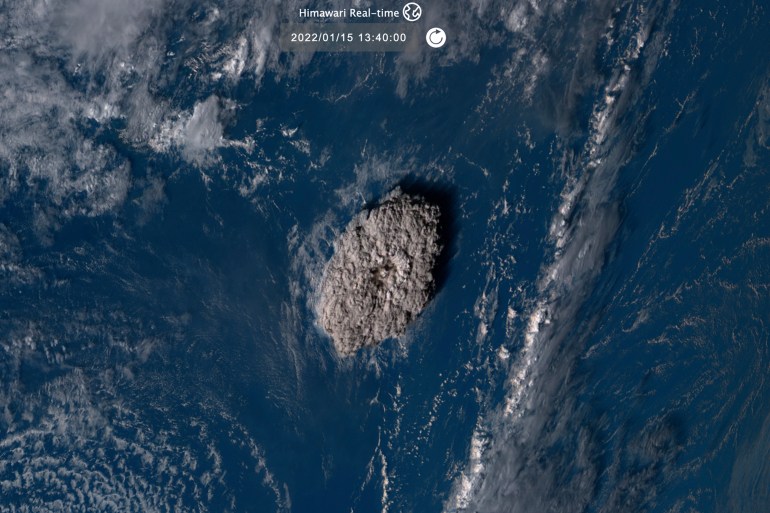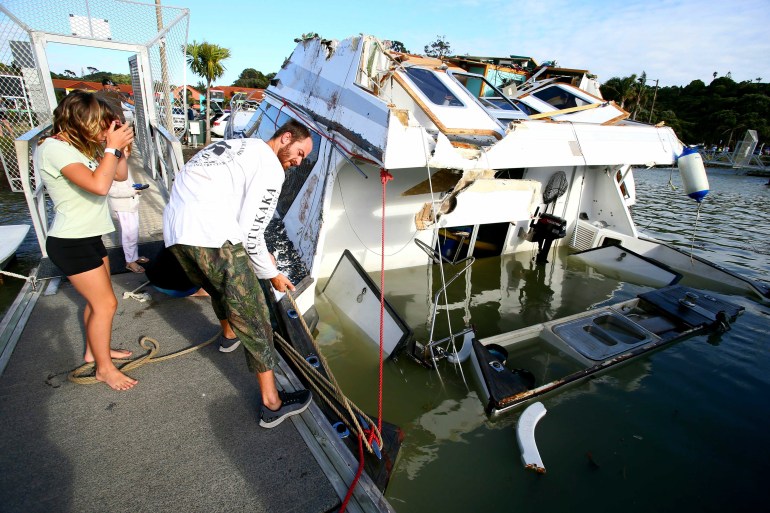The tsunami threat around the Pacific from a huge undersea volcanic eruption receded on Sunday, but a massive ash cloud covering the tiny island nation of Tonga prevented surveillance flights from New Zealand from assessing the extent of damage.
Satellite images showed the spectacular eruption of the Hunga Tonga-Hunga Ha’apai volcano that took place on Saturday with a plume of ash, steam and gas rising like a mushroom above the blue Pacific waters. A sonic boom could be heard as far away as Alaska.
In Tonga, it sent tsunami waves crashing across the shore and people rushing to higher ground.
The eruption cut the internet to Tonga, leaving friends and family members around the world anxiously trying to get in touch to figure out if there were any injuries. Even government websites and other official sources remained without updates on Sunday afternoon.
 This satellite image taken by Himawari 8, a Japanese weather satellite, shows an undersea volcano eruption at Tonga [NICT via AP]
This satellite image taken by Himawari 8, a Japanese weather satellite, shows an undersea volcano eruption at Tonga [NICT via AP]New Zealand Prime Minister Jacinda Ardern said there had not yet been any official reports of injuries or deaths in Tonga, but cautioned that authorities had not yet made contact with some coastal areas and smaller islands.
“Communication with Tonga remains very limited. And I know that is causing a huge amount of anxiety for the Tongan community here,” Ardern said.
She said there had been significant damage to boats and shops along the Tongan coastline.
The capital, Nuku’alofa, about 64km (40 miles) south of the volcano, was covered in a thick film of volcanic dust, Ardern said, contaminating water supplies and making freshwater a vital need.
Aid agencies said thick ash and smoke had prompted authorities to ask people to wear masks and drink bottled water.
Ardern said New Zealand was unable to send a surveillance flight over Tonga on Sunday because the ash cloud was 19km (63,000 feet) high. But efforts will continue on Monday, followed by supply planes and navy ships.

One complicating factor in any international aid effort is that Tonga has so far managed to avoid any outbreaks of COVID-19. Ardern said New Zealand’s military staff were all fully vaccinated and willing to follow any protocols established by Tonga.
Dave Snider, the tsunami warning coordinator for the National Tsunami Warning Center in Palmer, Alaska, said it was extremely unusual for a volcanic eruption to affect an entire ocean basin, and the spectacle was both “humbling and scary”.
Robin George Andrews, a science journalist, a volcanologist and author of Super Volcanoes, told Al Jazeera from London that “it was the most energetic [volcanic] explosions in the entire 21st century”.
“Unfortunately there was this giant explosion which scientists think is a one in a 1,000-year event for this sort of volcano. It takes about 1,000 years to fully recharge,” he said.
“So it just happened to be around that point where it unleashed a vast amount of magma in a very explosive way. That’s what created the explosion where it pushed the atmosphere out of the way … The shockwave has gone around the entire world.”
 A couple look at a damaged boat in a marina at Tutukaka, New Zealand [Tanya White/Northern Advcate/NZME via AP]
A couple look at a damaged boat in a marina at Tutukaka, New Zealand [Tanya White/Northern Advcate/NZME via AP]The tsunami waves caused damage to boats as far away as New Zealand and Santa Cruz, California, but did not appear to cause any widespread damage. Snider said he anticipated the tsunami situation in the United States and elsewhere to continue improving.
Tsunami advisories were earlier issued for Japan, Hawaii, Alaska, and the US Pacific coast.
The US Geological Survey estimated the eruption caused the equivalent of a magnitude 5.8 earthquake. Scientists said tsunamis generated by volcanoes rather than earthquakes are relatively rare.
Rachel Afeaki-Taumoepeau, who chairs the New Zealand Tonga Business Council, said she hoped the relatively low level of the tsunami waves would have allowed most people to get to safety, although she worried about those living on islands closest to the volcano.
She said she had not yet been able to contact her friends and family in Tonga. “We are praying that the damage is just to infrastructure and people were able to get to higher land.”
US Secretary of State Antony Blinken wrote on Twitter: “Deeply concerned for the people of Tonga as they recover from the aftermath of a volcanic eruption and tsunami. The United States stands prepared to provide support to our Pacific neighbours.”
Tonga gets its internet via an undersea cable from Suva, Fiji. All internet connectivity with Tonga was lost at about 6:40pm local time on Saturday, said Doug Madory, director of internet analysis for the network intelligence firm Kentik.
On Tonga, which is home to about 105,000 people, video posted to social media showed large waves washing ashore in coastal areas and swirling around homes, a church and other buildings.
A Twitter user called Dr Faka’iloatonga Taumoefolau posted a video showing waves crashing ashore.
“Can literally hear the volcano eruption, sounds pretty violent,” he wrote, adding in a later post: “Raining ash and tiny pebbles, darkness blanketing the sky.”
https://news.google.com/__i/rss/rd/articles/CBMiZWh0dHBzOi8vd3d3LmFsamF6ZWVyYS5jb20vbmV3cy8yMDIyLzEvMTYvdHN1bmFtaS10aHJlYXQtcmVjZWRlcy12b2xjYW5vLWFzaC1oaW5kZXJzLXJlc3BvbnNlLWluLXRvbmdh0gEA?oc=5
2022-01-16 12:46:11Z
1241536097
Tidak ada komentar:
Posting Komentar